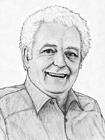 Robert A. Moog May 23, 1934 - August 21, 2005 (click drawing for a large version) |
|
A
good friend and
wonderful human being is no more. Bob Moog lost his battle
with a brain tumor on August 21, 2005, at his home in
Asheville, NC. He was surrounded by his family and died so
gradually and peacefully you couldn't be more exact than to
say it was around 2 PM. |
At
the end of the adventure, by the Spring of 1968, the first
custom velocity and depth sensitive keyboards (something I
was particularly involved with: physical construction,
reworking, final adjusting) were kludged together. Actually
EVERYthing Bob built always looked slick and professional,
even the kludges. Finally an album you've probably heard of
was about to become my "maiden voyage" with the synthesizer.
Other key people became involved, such as my collaborator
and producer, Rachel
Elkind-Tourre, who
was essential to the project. Rachel's the one who came up
with the idea for a Bach album, and sold it to CBS Records.
The title: "Switched-On
Bach," that was
CBS's suggestion, and a good one, snappier and more
memorable than ours ("The Electronic Bach"). --Wendy
Carlos |
|
Note:
Whenever I've lost someone dear to me it has generally felt
right and proper to create a pencil sketch of them to add to
the website, and have "floating around in the Ether" of the
Internet. The drawing at the top of this page is one I made
just after receiving word from Ileana that her husband's
condition was very grave. Four days later we learned that it
was over. In some haste I added the sketch with Bob's dates
to the Index Page, as a placeholder for this new page, which
now supplants that temporary addition. (Bob often spoke about its first public hearing, at the end of his AES lecture in NYC in the Fall of 1968.) Scarlatti: Sonata in G, K455, first portion [W-TS CD-track #2} (A mature example of the custom touch sensitive keyboard plus some tricky multitrack "hocketing.") Purcell: Funeral Music for Queen Mary [CO CD-track #3] (Steve Martin, the film director, wisely suggested I must play something appropriate to losing our friend.) Carlos: Beauty in the Beast --title track [BitB CD-track #2] (A piece I only learned recently Bob particularly loved, although he'd never mentioned this to me before.) |
In keeping with this page about Bob Moog's earliest modular synths, let's take a look at a few vintage pages from the first two synthesizer catalogs I ever saw from the R. A. Moog Company, in 1965 and 1967. The idea was to present the musician with essential information to assemble a collection of modules appropriate to the needs and budget. The first catalog was especially aimed at custom installations. So the descriptions were intended to guide one through what each "magic box and panel" did, and how much it cost. The second catalog from only two years later already shifts the focus to three sizes of pre-packaged instruments with a standard configuration which had proven valuable to the earliest users/guinea pigs (that would include me)... These are cleaned decent resolution scans from selected pages. This is the top page (there was no cover) of the original 1965 Moog Catalog. It was on regular bond paper, all held together by a staple in the upper left-hand corner. Nothing fancy back then, it was the preliminary information that was of interest. In this case, after a brief overview, we delve immediately into the voltage-controlled oscillator modules. HERE is page two of the 1965 Catalog. This page continues with the oscillator modules, including special output stages, then on to voltage controlled amplifiers, a special white-noise source, and the particularly crucial (and famous -- it's also Bob's main patent from the time) voltage-controlled filters. HERE is page five of the 1965 Catalog. It briefly describes several special products and services which in the earliest days had more value, when the synths by themselves were seen as rather odd all by themselves. This is the front of the 1967 Moog Catalog. The catalog had a bold, attractive physical cover, printed on a bristol-board heavyweight stock, slightly oversized from the standard-sized pages within. Everything was saddle-stiched together, a very trim and neat package. HERE is page ten of the 1967 Catalog. It features the larger Moog III instrument, which was approximately the size of my instrument at the same time, although with fewer of the idiosyncracies I preferred. HERE is page twenty-one of the 1967 Catalog, which continues the breakdown of modules with their prices, all of which certainly sound very modest to today's eyes. But actually they represented a considerable investment in the 60s, and I had to work on many free-lance projects to save enough to purchase some of the additions to my custom system. Finally
for historical sake, I thought you'd enjoy seeing the actual
stereo master mixdown tapes for the well-known album
completed just one year after the 1967 Catalog had come out.
You can see that we were still calling the album by our
working title: "The Electronic Bach" (there's a bit more on
the album above on this page). Here are a few technical
details for those interested:
Included in our new pdf
section are two interviews written by Bob Moog for Keyboard
Magazine in the fall of 1982, shortly after Disney's TRON
appeared, my filmscore for it being the point of departure
for the interviews. You can also access these articles by
clicking the appropriate image or link in the double box
below.
--(WC Sept. 2005, additions Oct-Dec. 2006) |
|||||||||
On Bob
Moog
©
1997-2008 Serendip LLC. No images, text, graphics or design
may be reproduced without permission. All Rights
Reserved.
![]()